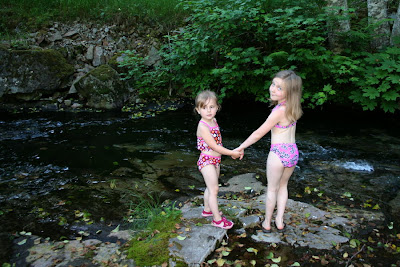61 degrees - 10:08 pm - quiet night...
Just
curious...how many of you out there cook with cast iron?
I didn’t
until recently. Can I just say that I
now love cooking with cast iron. Not because
it’s fancy and super duper high tech. It’s
quite the opposite. It’s a heavy duty,
mean, rustic, non-stick multi-purpose machine!
Whether
it be enchiladas, cornbread, frito beef skillet, or brownies, I know I can
count on my cast iron skillet to deliver the goods.
Here
are some helpful facts about cast iron that you should know:
Bare Cast Iron – Types of bare cast-iron
cookware include dutch ovens, frying pans, deep fryers, tetsubin, woks,
potjies, flattop grills and griddles.
Bare cast-iron vessles have been used for cooking for hundreds of years. Cast iron’s ability to withstand and maintain
very high cooking temperatures make it a common choice for searing or frying,
and its excellent heat diffusion and retention makes it a good option for
long-cooking stews or braised dishes.
Because cast iron skillets can develop an extremely “non-stick” surface,
they are also a good choice for egg dishes, particularly scrambled eggs. Other uses of cast iron pans include making
cornbread, peach cobbler and pineapple upside-down cake.
Health Effects – Cast iron cookware leaches
small amounts of iron into the food.
Anemics, and those with iron deficiencies, may benefit from this effect,
thought those with excess iron issues (for example, people with
hemochromatosis) may suffer negative effects.
Seasoning – A seasoned pan has a
stick-resistant coating created by polymerized oils and fats.
How To Season Your Cast Iron – 1.Heat the oven to 350
degrees F. Position one rack in the top third of the oven. Position another rack in the bottom third of the
oven and place an empty foil lined baking sheet on the bottom rack. This sheet will catch any drippings from the
cast iron.
2.Open
your windows or turn on your stove hood fan.
There may be a bit of smoke.
3.Over
a medium flame, rub a thin layer (about 1 Tablespoon) of vegetable shortening (like
Crisco), oil, or bacon grease works great too, all over the inner bottom and
sides of the pan with a paper towel and tongs.
4.Place
the oiled pan upside down in the heated oven over the foil lined baking
sheet.
5.Bake
the cast iron for 1 hour. Turn the oven
off and allow the cast iron to cool to room temperature in the oven. Repeat this process 3 or 4 times for best
results.
When
the pan is perfectly seasoned, the inside will be smooth and shiny.
Cleaning – Because ordinary cookware
cleaning techniques like scouring or washing in a dishwasher can remove or
damage the seasoning on a bare cast iron pan, these pans should not be cleaned
like most other cookware. Some cast iron
aficionados advocate never cleaning cast iron pans at all, simply wiping them
out after use, or washing them with hot water and a stiff brush. Others advocate washing with mild soap and
water, and then re-applying a thin layer of fat or oil. A third approach, advocated by chef Alton
Brown, is to scrub with coarse salt and paper towel or clean rag.
Now
that you got a little lesson on how hard this pan can work...here is a recipe
to indulge in, after your hard day at work!
~Cast Iron Skillet Brownies~
1 cup
sugar
3
large eggs
1 cup
all-purpose flour
1/2 cup
cocoa powder
1/2 teaspoon
salt
4 Tablespoons (half stick) unsalted butter
1/4 cup
heavy cream
8 oz
chocolate chips
Preheat
oven to 350 degrees. In a large bowl,
whisk together sugar and eggs. In another
bowl, whisk together flour, cocoa, and salt.
In a
medium cast iron skillet, bring butter and cream to a simmer over medium
heat. Add chocolate; reduce to
medium-low. Cook, stirring constantly,
until chocolate has melted, about 1 minute.
Remove from heat, and let cool 5 mintues.
Add
chocolate mixture to sugar mixture, whisking until blended (reserve
skillet). Fold in flour mixture. Pour batter into skillet.
Bake
until a toothpick inserted in center comes out clean, about 40 minutes. {Note: for a gooeyer brownie bake for about
35 minutes}
For an
even more decadent treat, serve with ice cream and strawberries!
This is
the perfect reward after a loooong day of being super
mom/wife/daughter/sister/chauffeur/housekeeper/chef/etc...
---Enjoy!
+-+Oregon+Grape.jpg)

+-+Stink+Currant.jpg)
+-+Red+Elderberry.jpg)
+-+Blue+Elderberry.jpg)
+-+Red+Huckleberry.jpg)
+-+Blue+Huckleberry.jpg)
+-+wild+blueberry.jpg)


+-+Trailing+Blackberry.jpg)
+-+Black+Cap.jpg)


.jpg)
.jpg)
.jpg)
.jpg)
.jpg)
.jpg)
.jpg)




.jpg)
.jpg)
.jpg)
.jpg)


.jpg)
.jpg)

.jpg)
.jpg)
.jpg)
.jpg)
.jpg)


